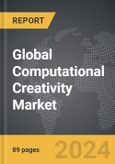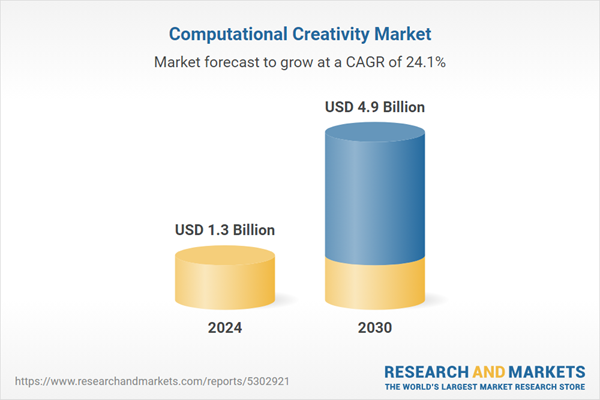Global Computational Creativity Market - Key Trends & Drivers Summarized
What Is Computational Creativity, and How Is It Transforming Creative Industries?
Computational creativity is an interdisciplinary field that uses artificial intelligence (AI) and machine learning to simulate and enhance human creativity in areas such as art, music, writing, and design. By leveraging algorithms, generative models, and neural networks, computational creativity applications can generate new content, suggest creative ideas, and assist artists, musicians, and writers in their work. This technology is increasingly utilized in sectors like advertising, entertainment, gaming, and digital media, where the demand for high-quality, original content is continuously growing. Computational creativity not only supports human creativity by offering fresh perspectives and ideas but also streamlines the creative process, making it faster and more efficient. The transformative power of computational creativity lies in its ability to automate complex, creative tasks that were traditionally exclusive to humans. With AI-driven creative tools, businesses and creators can generate an unlimited number of ideas, drafts, or designs, which can be used to explore concepts, produce variations, or create personalized content at scale. For example, in advertising, computational creativity enables the rapid generation of marketing copy, images, and videos tailored to different audience segments. In the gaming industry, it can create unique game levels, characters, and storylines, enhancing player engagement and variety. As industries face growing content demands and increasingly competitive markets, computational creativity offers a valuable toolset that enhances productivity and expands creative possibilities.How Are Technological Advancements Shaping the Computational Creativity Market?
Technological advancements in machine learning, neural networks, and natural language processing (NLP) are driving the growth and capabilities of computational creativity. Generative adversarial networks (GANs), for instance, have revolutionized content creation by generating realistic images, videos, and sounds, enabling AI to mimic and create human-like artistry. GANs are used in fields like digital art, animation, and game design, where they can produce high-quality visuals and audio at a fraction of the time and cost. Advances in NLP and transformers, such as OpenAI's GPT and BERT models, enable computational creativity applications to understand context and generate coherent, stylistic text, making them valuable for writing, storytelling, and language-based tasks.Another breakthrough is in reinforcement learning, which has enhanced AI's ability to develop complex, interactive environments and games that adapt to user input, creating unique experiences each time. This technology is particularly beneficial for gaming and virtual environments, where user engagement and immersion are priorities. Additionally, the integration of computational creativity with AR/VR and 3D modeling software has enabled the creation of immersive, interactive experiences in entertainment and e-learning. These technological innovations not only expand the potential of computational creativity but also make it more accessible, allowing artists, marketers, and developers to harness AI's capabilities to produce and iterate creative content more efficiently.
What Are the Key Applications of Computational Creativity Across Industries?
Computational creativity has a broad range of applications, each supporting different aspects of creative industries. In digital marketing and advertising, computational creativity is used to generate ad copy, graphics, and personalized content that resonates with target audiences, allowing brands to produce engaging, tailored campaigns more quickly and at scale. In music, AI-driven systems can compose, arrange, and remix music, assisting musicians in exploring new genres, harmonies, and rhythms. In the gaming industry, computational creativity is used to design characters, generate storylines, and build dynamic game levels that adapt to player actions, providing unique and interactive experiences.The film and entertainment industry also benefits from computational creativity in visual effects, script generation, and content creation for immersive experiences like virtual reality (VR) and augmented reality (AR). AI can create realistic animations and generate plot ideas, reducing production time and cost while enhancing creative possibilities. Computational creativity is also used in e-learning, where AI generates interactive content, quizzes, and simulations tailored to different learning styles, improving engagement and retention. These varied applications demonstrate the versatility of computational creativity, which enhances productivity and innovation in industries where content quality and novelty are essential to audience satisfaction and engagement.
What Factors Are Driving Growth in the Computational Creativity Market?
The growth in the computational creativity market is driven by several factors, including the increasing demand for content, advancements in AI technology, and the need for efficient creative processes. As digital consumption rises, industries such as entertainment, advertising, and gaming face intense pressure to deliver diverse, high-quality content consistently. Computational creativity allows these industries to meet this demand by generating novel ideas, designs, and content quickly, making it possible to produce and iterate creative work at a scale that would be challenging for humans alone. Technological advancements in deep learning, NLP, and computer vision have further expanded the capabilities of computational creativity, making AI-generated content more realistic, coherent, and adaptable to specific creative needs. Additionally, the growing acceptance of AI as a co-creative tool among artists and creators has driven adoption, as these tools are increasingly seen as partners that enhance human creativity rather than replace it. The potential for cost savings and faster production timelines in content-heavy sectors has also fueled demand, as computational creativity reduces the resources needed to produce high-quality work. As industries continue to embrace digital transformation, the demand for computational creativity tools that boost productivity, creativity, and content variety is expected to grow, supporting its role as a powerful, innovative force across creative fields.Report Scope
The report analyzes the Computational Creativity market, presented in terms of market value (US$ Thousand). The analysis covers the key segments and geographic regions outlined below.- Segments: Component (Solutions, Services); Technology (Natural Language Processing, Machine Learning & Deep Learning, Computer Vision); Application (Marketing & Web Designing, Product Designing, Music Composition, Photography & Videography, High-End Video Gaming Development, Other Applications).
- Geographic Regions/Countries:World; United States; Canada; Japan; China; Europe (France; Germany; Italy; United Kingdom; and Rest of Europe); Asia-Pacific; Rest of World.
Regional Analysis
Gain insights into the U.S. market, valued at $391.1 Million in 2024, and China, forecasted to grow at an impressive 23.3% CAGR to reach $741.5 Million by 2030. Discover growth trends in other key regions, including Japan, Canada, Germany, and the Asia-Pacific.Why You Should Buy This Report:
- Detailed Market Analysis: Access a thorough analysis of the Global Computational Creativity Market, covering all major geographic regions and market segments.
- Competitive Insights: Get an overview of the competitive landscape, including the market presence of major players across different geographies.
- Future Trends and Drivers: Understand the key trends and drivers shaping the future of the Global Computational Creativity Market.
- Actionable Insights: Benefit from actionable insights that can help you identify new revenue opportunities and make strategic business decisions.
Key Questions Answered:
- How is the Global Computational Creativity Market expected to evolve by 2030?
- What are the main drivers and restraints affecting the market?
- Which market segments will grow the most over the forecast period?
- How will market shares for different regions and segments change by 2030?
- Who are the leading players in the market, and what are their prospects?
Report Features:
- Comprehensive Market Data: Independent analysis of annual sales and market forecasts in US$ Million from 2024 to 2030.
- In-Depth Regional Analysis: Detailed insights into key markets, including the U.S., China, Japan, Canada, Europe, Asia-Pacific, Latin America, Middle East, and Africa.
- Company Profiles: Coverage of players such as Adobe, Aiva, Amper Music, Autodesk, Automated Creative and more.
- Complimentary Updates: Receive free report updates for one year to keep you informed of the latest market developments.
Some of the 34 companies featured in this Computational Creativity market report include:
- Adobe
- Aiva
- Amper Music
- Autodesk
- Automated Creative
- AWS
- B12
- Canva
- Cyanapse
- Firedrop
This edition integrates the latest global trade and economic shifts into comprehensive market analysis. Key updates include:
- Tariff and Trade Impact: Insights into global tariff negotiations across 180+ countries, with analysis of supply chain turbulence, sourcing disruptions, and geographic realignment. Special focus on 2025 as a pivotal year for trade tensions, including updated perspectives on the Trump-era tariffs.
- Adjusted Forecasts and Analytics: Revised global and regional market forecasts through 2030, incorporating tariff effects, economic uncertainty, and structural changes in globalization. Includes historical analysis from 2015 to 2023.
- Strategic Market Dynamics: Evaluation of revised market prospects, regional outlooks, and key economic indicators such as population and urbanization trends.
- Innovation & Technology Trends: Latest developments in product and process innovation, emerging technologies, and key industry drivers shaping the competitive landscape.
- Competitive Intelligence: Updated global market share estimates for 2025, competitive positioning of major players (Strong/Active/Niche/Trivial), and refined focus on leading global brands and core players.
- Expert Insight & Commentary: Strategic analysis from economists, trade experts, and domain specialists to contextualize market shifts and identify emerging opportunities.
Table of Contents
Companies Mentioned (Partial List)
A selection of companies mentioned in this report includes, but is not limited to:
- Adobe
- Aiva
- Amper Music
- Autodesk
- Automated Creative
- AWS
- B12
- Canva
- Cyanapse
- Firedrop
Table Information
| Report Attribute | Details |
|---|---|
| No. of Pages | 170 |
| Published | December 2025 |
| Forecast Period | 2024 - 2030 |
| Estimated Market Value ( USD | $ 1.3 Billion |
| Forecasted Market Value ( USD | $ 4.9 Billion |
| Compound Annual Growth Rate | 24.1% |
| Regions Covered | Global |









